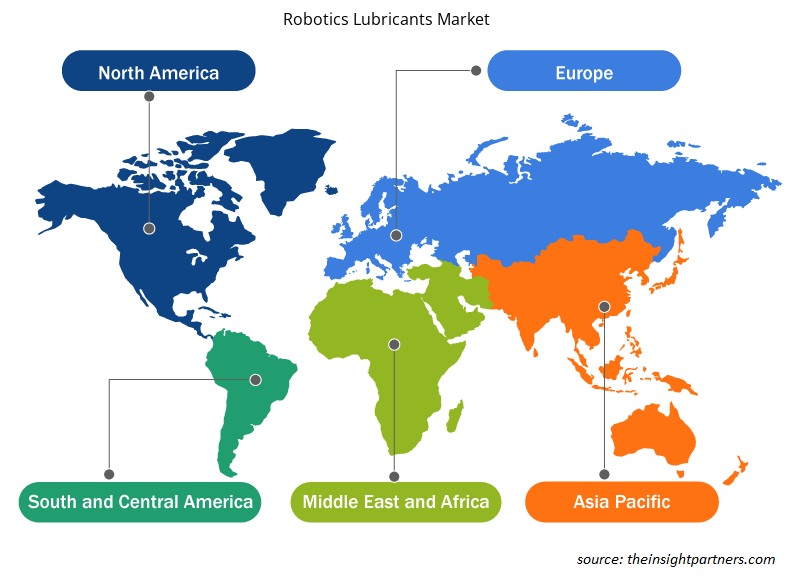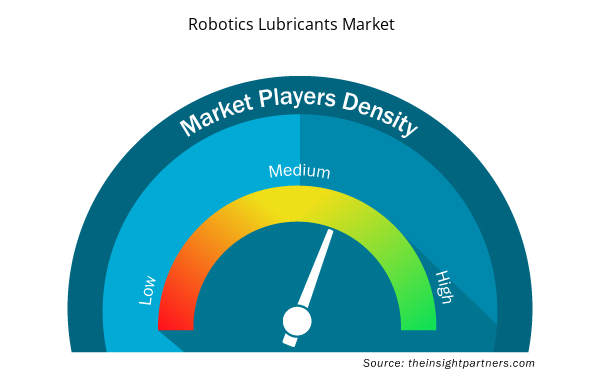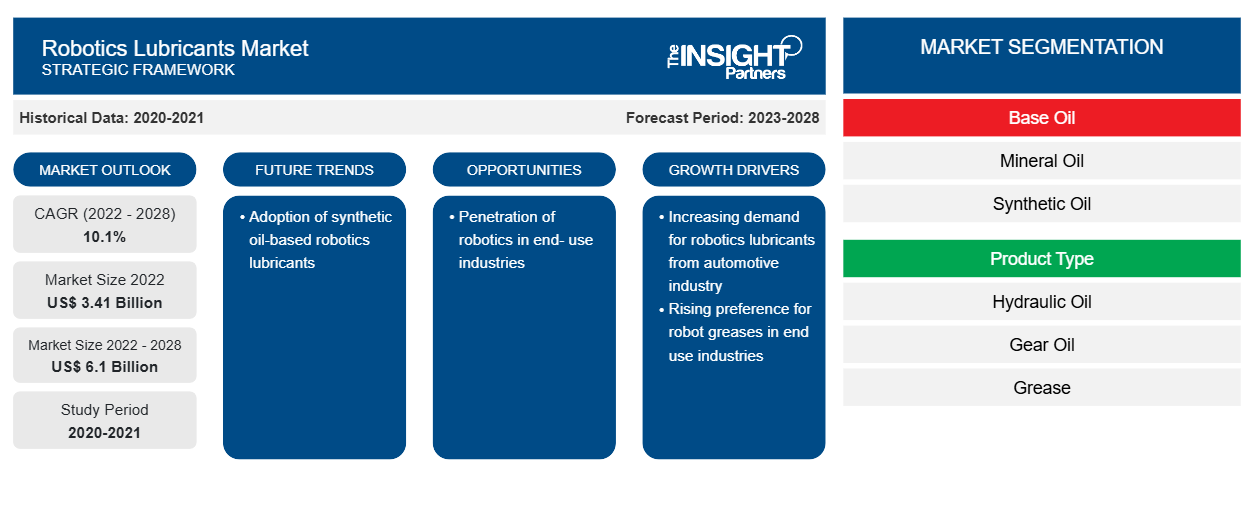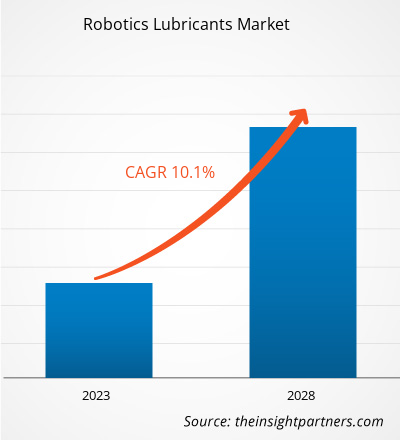[研究报告] 机器人润滑油市场规模预计将从 2022 年的 34.1372 亿美元增长到 2028 年的 60.9541 亿美元;预计 2022 年至 2028 年的复合年增长率为 10.1%。
市场分析
润滑剂用于减少表面之间的摩擦和产生的热量,从而延长相关表面的使用寿命。工业机器人涉及材料处理、装配和分配,因此它们会受到磨损和腐蚀的影响。机器人润滑剂的开发有助于减少工业机器人的停机时间,并对制造过程的质量、成本和效率产生积极影响。润滑剂由多种流体组成,可承受极端条件。油脂是机器人操作中广泛使用的润滑剂。
增长动力与挑战
终端行业对机器人润滑剂的需求不断增长,促进了机器人润滑剂市场的增长。在制造业中,机器人润滑剂是帮助设备以最高可靠性和最高效率运行的关键部件之一。润滑脂、液压油和齿轮油用于多个终端行业,包括汽车、电气和电子、食品和饮料、物流以及金属和机械制造。机器人润滑脂含有基础油(如矿物油或合成油)、增稠剂和添加剂,这些油赋予产品独特的品质。润滑脂具有多种特性,例如密封能力、低泄漏倾向、防腐蚀和重载处理。市面上有几种机器人润滑脂是食品级的,符合食品和饮料以及医疗保健等特定行业的某些国际标准。润滑脂会因摩擦和暴露在极端温度下而降解,直到其粘度水平不足以有效润滑内部机械部件。机器人润滑是维持机器人和机器人部件整体效率不可或缺的一部分。机器人润滑的推荐频率因品牌和型号而异。因此,润滑脂相对于其他润滑剂的优势以及终端行业对机器人润滑脂的偏好正在推动机器人润滑剂市场的发展。然而,全球经济状况的波动导致添加剂、基础油、运输和制造成本的增加。一些制造商见证了整个润滑剂供应链中的通胀压力以及润滑剂添加剂供应。2022 年,美国基础油价格从每加仑 2 美元上涨至每加仑 5 美元。此外,2022 年,FUCHS Lubricants Co 宣布其润滑剂添加剂产品组合价格上涨 8-12%,该价格从 2022 年 10 月开始实施。此外,2022 年,Ergon Inc 提高了环烷基础油的价格。然而,2023 年,雪佛龙公司宣布基础油价格下降 0.20 至 0.50 美元。因此,原材料价格波动正在抑制机器人润滑剂市场的增长。
定制此报告以满足您的需求
您可以免费定制任何报告,包括本报告的部分内容、国家级分析、Excel 数据包,以及为初创企业和大学提供优惠和折扣
- 获取此报告的关键市场趋势。这个免费样品将包括数据分析,从市场趋势到估计和预测。
报告分类和范围
“2028 年全球机器人润滑油市场分析”是一项专业而深入的研究,主要关注全球机器人润滑油市场趋势和增长机会。该报告旨在概述全球机器人润滑油市场,并按基础油、产品类型、最终用途行业和地域对市场进行详细细分。全球机器人润滑油市场近年来一直保持高增长,预计在预测期内将继续保持这一趋势。该报告提供了全球机器人润滑油消费量的关键统计数据以及主要地区和国家的需求。此外,该报告还对影响主要地区和国家机器人润滑油市场表现的各种因素进行了定性评估。该报告还包括对机器人润滑油市场主要参与者及其关键战略发展的全面分析。还包括对市场动态的几项分析,以帮助确定关键驱动因素、市场趋势和有利可图的机器人润滑油市场机会,进而有助于确定主要收入来源。
此外,生态系统分析和波特五力分析提供了全球机器人润滑油市场的360度视角,有助于了解整个供应链和影响市场增长的各种因素。
节段分析
全球机器人润滑油市场根据基础油、产品类型和最终用途行业进行细分。根据基础油,机器人润滑油市场细分为矿物油、合成油和其他。根据产品类型,市场分为液压油、齿轮油和润滑脂。根据最终用途行业,市场分为汽车、食品和饮料、医疗保健、电气和电子、金属和其他制造业。
基于矿物油,矿物油占据了机器人润滑油市场的很大份额。许多润滑油制造商提供多用途润滑油,用于机器人齿轮部件、链条、轴承和螺纹连接。嘉实多有限公司提供矿物基齿轮油,包括 Optigear ALR 320、Optigear BM 100 和 Alpha SP 320,适用于所有或部分机器人轴向应用。根据产品类型,润滑脂细分市场在机器人润滑油市场中占据最大市场份额。根据最终用途行业,汽车占据了机器人润滑油市场的主要份额。电气和电子细分市场预计将在预测期内实现最快的复合年增长率。
区域分析
该报告详细介绍了全球机器人润滑油市场,涉及五个主要地区,即北美、欧洲、亚太地区 (APAC)、中东和非洲 (MEA) 以及南美和中美。亚太地区占据了相当大的市场份额,2022 年的价值超过 19 亿美元。由于汽车和电子行业的增长以及工业化的提高,导致制造业的需求增加,亚太地区是机器人润滑油的主要市场。由于电气和电子行业对机器人润滑油的使用越来越多,预计欧洲也将出现相当大的增长,到 2028 年将超过 12 亿美元。预计北美从 2022 年到 2028 年的复合年增长率将达到 9% 左右。
行业发展和未来机遇
合作、收购和新产品发布被发现是全球机器人润滑油市场参与者所采用的主要策略。
2023年4月,FUCHS公司推出了“RENOLIT ROBO-G 0”——一种用于机器人润滑的润滑脂。它是一种基于锂复合皂和矿物油的半液体极压(EP)润滑脂。该产品旨在应用于工业机器人、机床和圆桌等精密齿轮。
机器人润滑油市场区域洞察
Insight Partners 的分析师已详尽解释了预测期内影响机器人润滑油市场的区域趋势和因素。本节还讨论了北美、欧洲、亚太地区、中东和非洲以及南美和中美洲的机器人润滑油市场细分和地理位置。

- 获取机器人润滑油市场的区域特定数据
机器人润滑油市场报告范围
| 报告属性 | 细节 |
|---|---|
| 2022 年市场规模 | 34.1亿美元 |
| 2028 年市场规模 | 61亿美元 |
| 全球复合年增长率(2022 - 2028) | 10.1% |
| 史料 | 2020-2021 |
| 预测期 | 2023-2028 |
| 涵盖的领域 | 按基础油分类
|
| 覆盖地区和国家 | 北美
|
| 市场领导者和主要公司简介 |
|
机器人润滑油市场参与者密度:了解其对业务动态的影响
机器人润滑油市场正在快速增长,这得益于终端用户需求的不断增长,而这些需求又源于消费者偏好的不断变化、技术进步以及对产品优势的认识不断提高等因素。随着需求的增加,企业正在扩大其产品范围,进行创新以满足消费者的需求,并利用新兴趋势,从而进一步推动市场增长。
市场参与者密度是指在特定市场或行业内运营的企业或公司的分布情况。它表明在给定市场空间中,相对于其规模或总市场价值,有多少竞争对手(市场参与者)存在。
在机器人润滑油市场运营的主要公司有:
- 米勒-史蒂芬森公司
- 壳牌国际有限公司
- 福克斯石油公司
- 英国石油公司
- 出光兴产株式会社
免责声明:上面列出的公司没有按照任何特定顺序排列。

- 获取机器人润滑油市场顶级关键参与者概述
新冠肺炎疫情的影响/地缘政治形势的影响/经济衰退的影响
由于 COVID-19 疫情导致的封锁、旅行限制和企业停工对北美、欧洲、亚太地区 (APAC)、南美和中美以及中东和非洲 (MEA) 等多个国家的经济和行业产生了不利影响。这场危机扰乱了全球供应链、制造活动、交付计划以及必需品和非必需品销售。多家公司宣布,2020 年产品交付可能会延迟,其产品未来销量可能会下滑。此外,欧洲、亚太地区和北美各国政府实施的国际旅行禁令迫使多家公司终止合作和伙伴关系计划。所有这些因素都阻碍了 2020 年和 2021 年初的化学品和材料行业,从而抑制了与该行业相关的各个市场(包括机器人润滑油市场)的增长。
在 COVID-19 疫情爆发之前,机器人润滑油市场主要受到汽车和电子行业不断增长的需求推动。然而,在 2020 年,由于国家和国际边界关闭导致价值链中断,各行业不得不放慢运营速度。由于各国政府当局实施的限制,COVID-19 疫情扰乱了关键原材料的供应链,并扰乱了制造流程。这些因素减少了机器人润滑油的产量。
竞争格局和主要公司
机器人润滑油市场的一些主要参与者包括 Miller-Stephenson Inc、Shell International BV、Fuchs、Petrolub SE、BP Plc、Idemitsu Kosan Co Ltd、Chemie-Technik GmbH、Anand Engineer Pvt Ltd、Kluber Lubrication GmbH & Co KG 和 Schaeffler Austria GmbH 等。
- 历史分析(2 年)、基准年、预测(7 年)及复合年增长率
- PEST 和 SWOT 分析
- 市场规模价值/数量 - 全球、区域、国家
- 行业和竞争格局
- Excel 数据集



Report Coverage
Revenue forecast, Company Analysis, Industry landscape, Growth factors, and Trends

Segment Covered
This text is related
to segments covered.

Regional Scope
North America, Europe, Asia Pacific, Middle East & Africa, South & Central America

Country Scope
This text is related
to country scope.
常见问题
The automotive segment held the largest share of the market in 2022. Automotive assembly lines encompass several challenges such as potential for injury, handling of high load components, slow production time, and quality inspection. Therefore, automotive industry deploys robots to overcome aforementioned challenges.
In 2022, Asia Pacific held the largest revenue share of the global robotics lubricants market is expected to register the highest CAGR from 2022 to 2028. The robotics lubricants market growth in Japan, China, South Korea, Singapore, Taiwan, and Vietnam is attributed to growing manufacturing sector in the region. Asia Pacific is manufacturing hub for automotive and electronics industries with China, Japan, and South Korea playing major role in installation of robotics for manufacturing process.
Asia Pacific is estimated to register the highest CAGR in the global robotics lubricants market over the forecast period. The growth of the robotics lubricants market in Asia-Pacific is driven by rising demand for robotics lubricants from various end-use industries such as automotive, food and beverage, medical and healthcare, electrical and electronics, metals, and other manufacturing industries.
The major players operating in the global robotics lubricants market are Miller-Stephenson Inc, Shell International BV, Fuchs Petrolub SE, BP Plc, Idemitsu Kosan Co Ltd, Chemie-Technik GmbH, Anand Engineer Pvt Ltd, Kluber Lubrication GmbH & Co KG, and Schaeffler Austria GmbH.
The mineral oil segment held the largest market share. Mineral oil is the most commonly used base oil in lubricant formulations. Paraffinic mineral oils possess several advantages such as high viscosity index and high flash point.
The grease segment held the largest share of the market in 2022. Robotic greases generally consist of mineral or semi-synthetic base oil with viscosity ranging from 40 to 175 centistokes. NLGI (National Lubricating Grease Institute) 0 or NLGI 00 greases are generally preferred for application in robotic joints.
Trends and growth analysis reports related to Chemicals and Materials : READ MORE..
The List of Companies - Robotics Lubricants Market
- Miller-Stephenson Inc
- Shell International BV
- Fuchs Petrolub SE
- BP Plc
- Idemitsu Kosan Co Ltd
- Chemie-Technik GmbH
- Anand Engineer Pvt Ltd
- Kluber Lubrication GmbH & Co KG
- Schaeffler Austria GmbH
- ASV Multichemie Pvt Ltd
The Insight Partners performs research in 4 major stages: Data Collection & Secondary Research, Primary Research, Data Analysis and Data Triangulation & Final Review.
- Data Collection and Secondary Research:
As a market research and consulting firm operating from a decade, we have published and advised several client across the globe. First step for any study will start with an assessment of currently available data and insights from existing reports. Further, historical and current market information is collected from Investor Presentations, Annual Reports, SEC Filings, etc., and other information related to company’s performance and market positioning are gathered from Paid Databases (Factiva, Hoovers, and Reuters) and various other publications available in public domain.
Several associations trade associates, technical forums, institutes, societies and organization are accessed to gain technical as well as market related insights through their publications such as research papers, blogs and press releases related to the studies are referred to get cues about the market. Further, white papers, journals, magazines, and other news articles published in last 3 years are scrutinized and analyzed to understand the current market trends.
- Primary Research:
The primarily interview analysis comprise of data obtained from industry participants interview and answers to survey questions gathered by in-house primary team.
For primary research, interviews are conducted with industry experts/CEOs/Marketing Managers/VPs/Subject Matter Experts from both demand and supply side to get a 360-degree view of the market. The primary team conducts several interviews based on the complexity of the markets to understand the various market trends and dynamics which makes research more credible and precise.
A typical research interview fulfils the following functions:
- Provides first-hand information on the market size, market trends, growth trends, competitive landscape, and outlook
- Validates and strengthens in-house secondary research findings
- Develops the analysis team’s expertise and market understanding
Primary research involves email interactions and telephone interviews for each market, category, segment, and sub-segment across geographies. The participants who typically take part in such a process include, but are not limited to:
- Industry participants: VPs, business development managers, market intelligence managers and national sales managers
- Outside experts: Valuation experts, research analysts and key opinion leaders specializing in the electronics and semiconductor industry.
Below is the breakup of our primary respondents by company, designation, and region:

Once we receive the confirmation from primary research sources or primary respondents, we finalize the base year market estimation and forecast the data as per the macroeconomic and microeconomic factors assessed during data collection.
- Data Analysis:
Once data is validated through both secondary as well as primary respondents, we finalize the market estimations by hypothesis formulation and factor analysis at regional and country level.
- Macro-Economic Factor Analysis:
We analyse macroeconomic indicators such the gross domestic product (GDP), increase in the demand for goods and services across industries, technological advancement, regional economic growth, governmental policies, the influence of COVID-19, PEST analysis, and other aspects. This analysis aids in setting benchmarks for various nations/regions and approximating market splits. Additionally, the general trend of the aforementioned components aid in determining the market's development possibilities.
- Country Level Data:
Various factors that are especially aligned to the country are taken into account to determine the market size for a certain area and country, including the presence of vendors, such as headquarters and offices, the country's GDP, demand patterns, and industry growth. To comprehend the market dynamics for the nation, a number of growth variables, inhibitors, application areas, and current market trends are researched. The aforementioned elements aid in determining the country's overall market's growth potential.
- Company Profile:
The “Table of Contents” is formulated by listing and analyzing more than 25 - 30 companies operating in the market ecosystem across geographies. However, we profile only 10 companies as a standard practice in our syndicate reports. These 10 companies comprise leading, emerging, and regional players. Nonetheless, our analysis is not restricted to the 10 listed companies, we also analyze other companies present in the market to develop a holistic view and understand the prevailing trends. The “Company Profiles” section in the report covers key facts, business description, products & services, financial information, SWOT analysis, and key developments. The financial information presented is extracted from the annual reports and official documents of the publicly listed companies. Upon collecting the information for the sections of respective companies, we verify them via various primary sources and then compile the data in respective company profiles. The company level information helps us in deriving the base number as well as in forecasting the market size.
- Developing Base Number:
Aggregation of sales statistics (2020-2022) and macro-economic factor, and other secondary and primary research insights are utilized to arrive at base number and related market shares for 2022. The data gaps are identified in this step and relevant market data is analyzed, collected from paid primary interviews or databases. On finalizing the base year market size, forecasts are developed on the basis of macro-economic, industry and market growth factors and company level analysis.
- Data Triangulation and Final Review:
The market findings and base year market size calculations are validated from supply as well as demand side. Demand side validations are based on macro-economic factor analysis and benchmarks for respective regions and countries. In case of supply side validations, revenues of major companies are estimated (in case not available) based on industry benchmark, approximate number of employees, product portfolio, and primary interviews revenues are gathered. Further revenue from target product/service segment is assessed to avoid overshooting of market statistics. In case of heavy deviations between supply and demand side values, all thes steps are repeated to achieve synchronization.
We follow an iterative model, wherein we share our research findings with Subject Matter Experts (SME’s) and Key Opinion Leaders (KOLs) until consensus view of the market is not formulated – this model negates any drastic deviation in the opinions of experts. Only validated and universally acceptable research findings are quoted in our reports.
We have important check points that we use to validate our research findings – which we call – data triangulation, where we validate the information, we generate from secondary sources with primary interviews and then we re-validate with our internal data bases and Subject matter experts. This comprehensive model enables us to deliver high quality, reliable data in shortest possible time.


 获取此报告的免费样本
获取此报告的免费样本